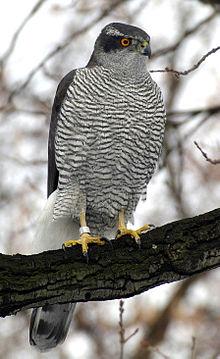Northern goshawk
| Northern goshawk | |
|---|---|
 |
|
| Adult | |
| Scientific classification | |
| Kingdom: | Animalia |
| Phylum: | Chordata |
| Class: | Aves |
| Order: | Accipitriformes |
| Family: | Accipitridae |
| Genus: | Accipiter |
| Species: | A. gentilis |
| Binomial name | |
|
Accipiter gentilis (Linnaeus, 1758) |
|
| Subspecies | |
|
|
 |
|
| Range of A. gentilis Breeding range Year-round range Wintering range | |
The northern goshawk /ˈɡɒs.hɔːk/ (Old English: gōsheafoc, "goose-hawk"), Accipiter gentilis, is a medium-large raptor in the family Accipitridae, which also includes other extant diurnal raptors, such as eagles, buzzards and harriers. As a species in the Accipiter genus, the goshawk is often considered a "true hawk". The scientific name is Latin; Accipiter is "hawk", from accipere, "to grasp", and gentilis is "noble" or "gentle" because in the Middle Ages only the nobility were permitted to fly goshawks for falconry.
This species was first described by Linnaeus in his Systema naturae in 1758 under its current scientific name.
It is a widespread species that inhabits many of the temperate parts of the Northern Hemisphere. The northern goshawk is the only species in the Accipiter genus found in both Eurasia and North America. It may have the widest distribution of any true member of the Accipitridae family, behind arguably only the hen harrier (Circus cyaenus) (which is often considered two species between North America and Eurasia) and occurring over a slightly wider range than either golden eagles (Aquila chrysaetos) or rough-legged buzzards (Buteo lagopus). With the exception of a small portion of southern Asia, it is the only species of "goshawk" in its range and it is thus often referred to, both officially and unofficially, as simply the "goshawk". It is mainly resident, but birds from colder regions migrate south for the winter. In North America, migratory goshawks are often seen migrating south along mountain ridge tops at nearly any time of the fall depending on latitude.
...
Wikipedia

